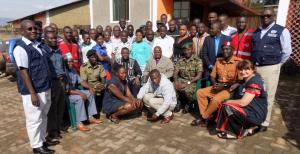Uganda Intensifies Ebola Community Engagement to Reach Individuals, Families, the Vulnerable and Hard-to-Reach Populations
Fort Portal, 22nd November 2018:- As the current Ebola Virus Disease (EVD) escalates in the Democratic Republic of Congo (DRC) closer to the Uganda border, there is a detectable sense of urgency exhibited in the heightened implementation of preparatory activities especially in the high-risk districts bordering DRC.
Consequently, health authorities have now decided to take Ebola messages with accompanying protective actions even closer to the people i.e. at individual, family and community levels. The intention is to “leave no stone unturned”, by ensuring that before a single case is registered in the country, all people, especially in high-risk districts bordering DRC know how to protect themselves against EVD, can identify alert cases, and can report them promptly.
This comes against the backdrop of warnings from health experts who predict that detection of an EVD case in Uganda might be a question of when not if. Therefore, extending EVD messages to community, family and individual levels is a step beyond the mere raising of awareness. A recent quick survey has indicated that EVD awareness in the community is sufficiently high but the corresponding risk perception and adoption of desired protective behaviours are glaringly very low.
The EVD Risk Communication teams have raised community awareness through radio messages, talk shows, mobile community film shows and distribution of IEC materials. However, there is limited Community Engagement (CE) to assist people deeply explore the EVD threat, for people to appreciate the potential dangers and for them to clearly define the measures to take at individual, family and community levels, should a case be detected in the country.
In fact, a recent WHO Independent Oversight Advisory Committee (IOAC) mission to Uganda recommended more work on CE to ensure that all individuals, families and communities are reached with EVD information. CE implementers are now required to go deep and wide in communities and even target hard-to-reach populations and the most vulnerable.
Presently, risk communication capacity in many districts is very weak, which partly explains the inadequacies noted by the IOAC. Consequently, the most valuable contribution of risk communication to EVD preparatory and response activities is lost in ambiguity, quality and weak field presence.
Partner organizations including WHO, UNICEF and Uganda Red Cross have tried to assist the Ministry of Health (MoH) and the districts, to address this challenge by engaging and deploying national CE officers who have so far done commendable work. In a considerably short time, these officers have mapped communities; identified and worked with influential community people; mobilized people through house-to-house visits; conducted community dialogues; engaged religious, civic and cultural leaders; counseled individuals and distributed Information, Education and Communication materials.
Yet despite these efforts, there is need for more work, especially at individual, family and community levels. Besides, challenges of sustainability, local context and appropriateness of language are amplified as “outside” CE officers intensify their community-based activities in the high-risk districts.
This fact is not lost to the partners and that is why the MoH with support from WHO has identified and trained 50 district-based CE officers and equipped them with knowledge and skills to cascade EVD information to the community, household and individual levels. The trained people are mainly District Health Teams (DHTs) members, security officers, religious leaders and a few other reliable and readily available persons from partner organizations and stakeholders.
If the cascade training goes as planned, it will result in every village having at least two Village Health Team Members constantly engaging communities, families and individuals on EVD, every day. This will increases EVD risk perception in the communities and contribute to overall preparedness and response.
In addition, the CE officers have also been armed with disease surveillance skills to identify and promptly report EVD alert or suspected cases that may occur in communities. This should facilitate quicker detection of alert or suspected cases and evacuation to appropriate management facilities that have been constructed in all the high-risk districts.
Kindly follow us on Social Media:
Health Promotion Advisor
Tel. : +256 414 335505
Cell: +256 772 507906
Email: sensasib [at] who.int (sensasib[at]who[dot]int)
Public Information Officer
Tel. : +256 313 335569
Cell: +256 786 497073
Email: mwebembezie [at] who.int (mwebembezie[at]who[dot]int)



